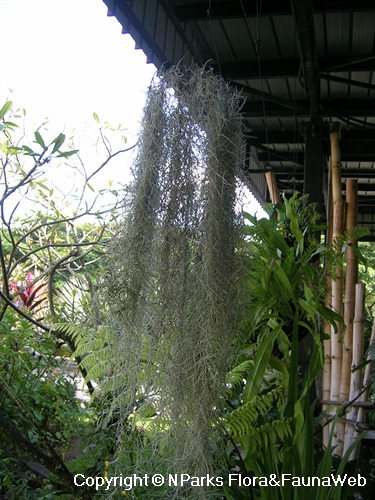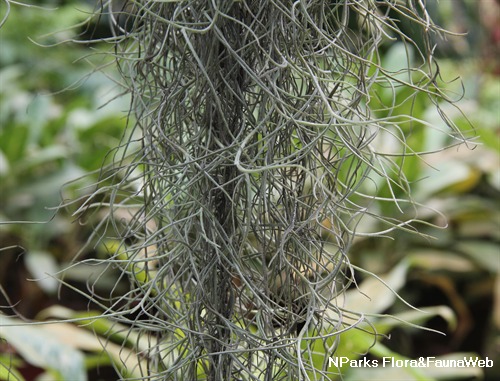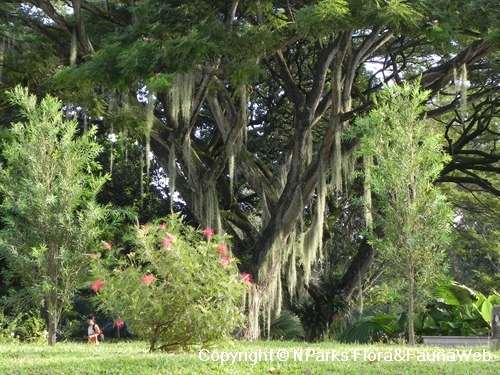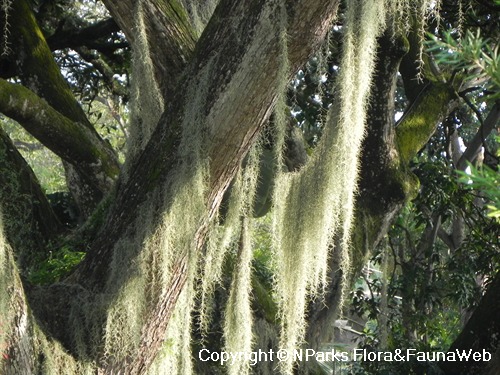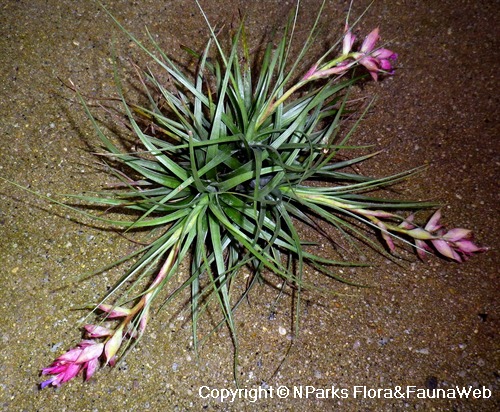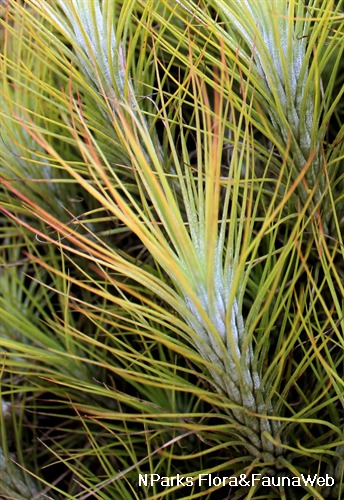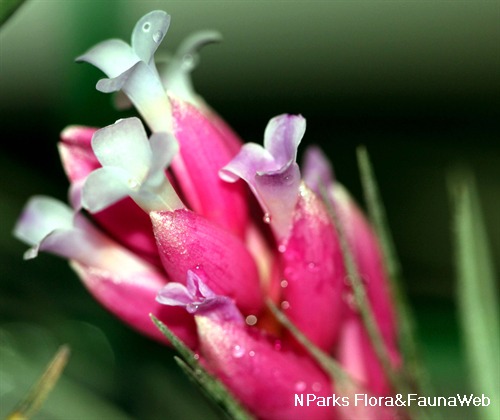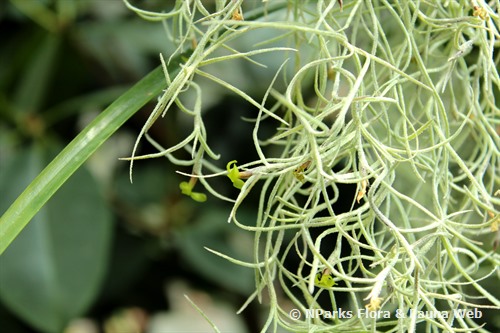
Back
Tillandsia usneoides (L.) L.
| Family Name: | Bromeliaceae |
| Synonyms: | Dendropogon usneoides, Tillandsia usneoides f. genuina, Strepsia usneoides, Abromeitiella usneoides |
| Common Name: | Spanish Moss, Old Man's Beard, Long Moss, Black Moss, 松萝凤梨, 老人须 |
Name
Classifications and Characteristics
| Plant Division | Angiosperms (Flowering Seed Plants) (Monocotyledon) |
|---|---|
| Plant Growth Form | Epiphyte |
| Lifespan (in Singapore) | Perennial |
| Mode of Nutrition | Autotrophic |
| Maximum Height | 15 m to 25 m |
Biogeography
| Native Distribution | Southern USA, South America |
|---|---|
| Preferred Climate Zone | Tropical, Sub-Tropical / Monsoonal |
| Local Conservation Status | Non-native (Horticultural / Cultivated Only) |
Description and Ethnobotany
| Growth Form | Herbaceous epiphyte grows in long, thick, tangled chains. |
|---|---|
| Roots | This species doesn't have roots. |
| Foliage | Thin, short leaves (1.5 - 3 cm long, 0.1 - 0.2 cm wide) occur in small twisted clusters. Leaves are densely covered in short, silver to grey hairs known as trichomes. The hairs help to absorb moisture and nutrients from the air. Leaves are silver to grey when dry, but light green when wet. |
| Stems | Stems are thin and elongate. |
| Flowers | Small, inconspicuous flowers are pale green or blue and are most fragrant at night. In cultivation, they seldom produce flowers. |
| Habitat | Occurs in many types of subtropical and tropical habitats. Usually found hanging from tree branches, especially those of oak and cypress. |
| Cultivation | This species is easy to grow. Simply hang the plants in partial shade and mist regularly with lukewarm water. It grows best in warm, humid environments and does not require fertilizer. Propagate by division. Remove several leaf clusters and hang them in a new location. |
| Etymology | The genus Tillandsia was named after Swedish botanist Dr. Elias Tillands (1640 - 1693) who had a phobia of water and refused to travel by boat. This genus was named after him, because plants in this genus often hang in air from branches, appearing to avoid water. The species epithet "usneoides" means that it resembles lichens in the genus Usnea ("-oides" meaning "similar to"). This species is commonly known as "Spanish moss," but it is a bromeliad and not a true moss. It is also colloquially known as "air plant," because it does not require soil to grow. |
| Ethnobotanical Uses | Medicinal: It is brewed as a tea to treat diabetes, rheumatism and gallbladder problems. Others: This species is often used as filler material for floral arrangements and wreaths. It is also used to cover the soil surface of potted plants for a more decorative look. This species accumulates mercury and has been used to detect the presence of mercury in the atmosphere (Filho et al 2002). Prior to the 1960s, this species was used to stuff mattresses, cushions and car seats in the U.S. and Europe. |
Landscaping Features
| Desirable Plant Features | Ornamental Foliage |
|---|---|
| Landscape Uses | General, Interiorscape/ Indoor Plant |
Plant Care and Propagation
| Light Preference | Semi-Shade, [Remarks] (Prefers regular misting) |
|---|---|
| Water Preference | Occasional Misting, [Remarks] (Prefers regular misting) |
| Rootzone Tolerance | Easy to Grow, Shallow Media |
| Maintenance Requirements | Low |
| Propagation Method | Division |
Foliar
| Mature Foliage Colour(s) | Silver / Grey |
|---|---|
| Mature Foliage Texture(s) | Velvety / Furry / Tomentose |
| Foliar Type | Simple / Unifoliate |
| Foliar Shape(s) | Non-Palm Foliage (Linear) |
| Foliar Venation | Parallel |
| Foliar Margin | Entire |
| Foliar Apex - Tip | Acute |
| Foliar Base | Truncate / Square |
| Typical Foliar Area | Leptophyll (<0.25 cm2 ), Nanophyll ( 0.25cm2 - 2.25 cm2 ) |
| Leaf Area Index (LAI) for Green Plot Ratio | 3.5 (Shrub & Groundcover - Monocot) |
Non - Foliar and Storage
| Stem Type & Modification | Herbaceous |
|---|
Floral (Angiosperm)
| Flower Colour(s) | Blue, Green |
|---|
Image Repository
Others
| Master ID | 1222 |
|---|---|
| Species ID | 2515 |
| Flora Disclaimer | The information in this website has been compiled from reliable sources, such as reference works on medicinal plants. It is not a substitute for medical advice or treatment and NParks does not purport to provide any medical advice. Readers should always consult his/her physician before using or consuming a plant for medicinal purposes. |

